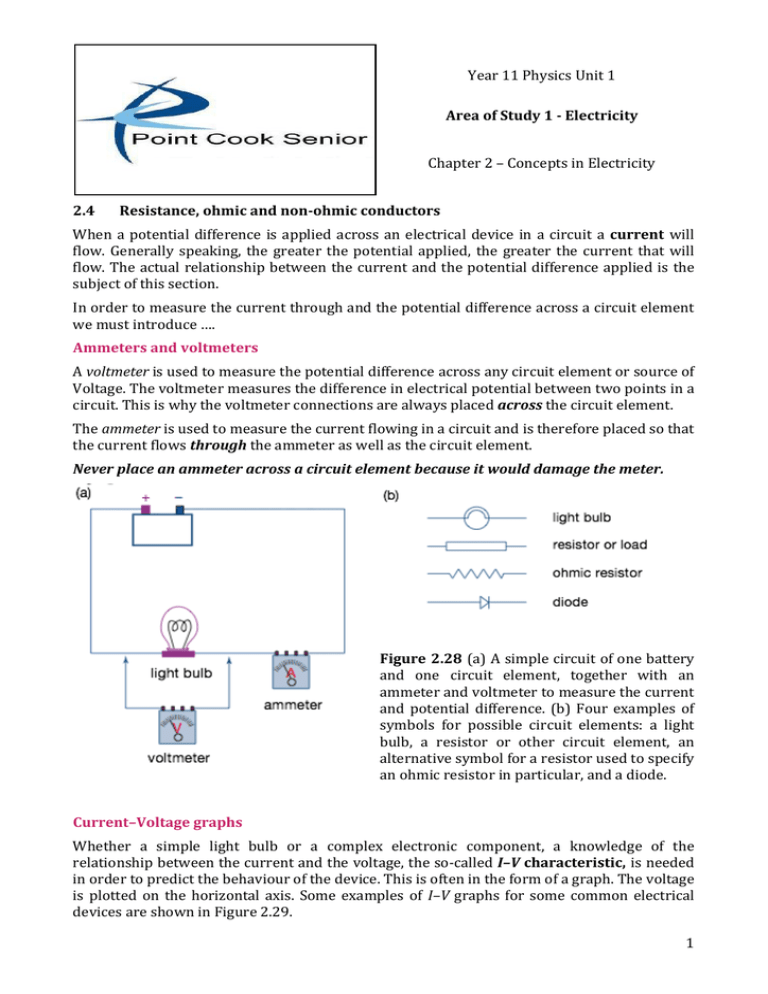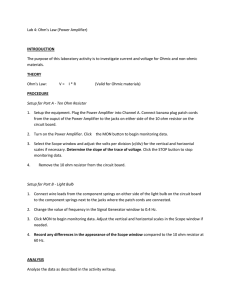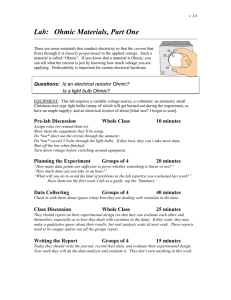2.4 Physics notes
advertisement

Year 11 Physics Unit 1 Area of Study 1 -­‐ Electricity Chapter 2 – Concepts in Electricity 2.4 Resistance, ohmic and non-­‐ohmic conductors When a potential difference is applied across an electrical device in a circuit a current will flow. Generally speaking, the greater the potential applied, the greater the current that will flow. The actual relationship between the current and the potential difference applied is the subject of this section. In order to measure the current through and the potential difference across a circuit element we must introduce …. Ammeters and voltmeters A voltmeter is used to measure the potential difference across any circuit element or source of Voltage. The voltmeter measures the difference in electrical potential between two points in a circuit. This is why the voltmeter connections are always placed across the circuit element. The ammeter is used to measure the current flowing in a circuit and is therefore placed so that the current flows through the ammeter as well as the circuit element. Never place an ammeter across a circuit element because it would damage the meter. Figure 2.28 (a) A simple circuit of one battery and one circuit element, together with an ammeter and voltmeter to measure the current and potential difference. (b) Four examples of symbols for possible circuit elements: a light bulb, a resistor or other circuit element, an alternative symbol for a resistor used to specify an ohmic resistor in particular, and a diode. Current–Voltage graphs Whether a simple light bulb or a complex electronic component, a knowledge of the relationship between the current and the voltage, the so-­‐called I–V characteristic, is needed in order to predict the behaviour of the device. This is often in the form of a graph. The voltage is plotted on the horizontal axis. Some examples of I–V graphs for some common electrical devices are shown in Figure 2.29. 1 Figure 2.29 examples of the relationship between current and applied potential difference for three common electrical devices. We can divide these devices into two groups: those that have a straight I–V graph and those that do not. The resistor is in the first group, the light bulb and the diode are in the second. Those with a straight I–V characteristic are called ohmic conductors and those which don’t are (rather logically) called non-­‐ohmic conductors. Resistance Georg Ohm (1789–1854) found that if the temperature of a metal wire was kept constant, the current flowing through it was directly proportional to the potential placed across it: I ∝ V. This is known as Ohm’s law. Rather than writing this as I = kV (where k is the slope of the I–V graph) this relationship is normally written the other way around as V = IR, where R is called the resistance (it is the inverse of the gradient). So Ohm basically said that the resistance of a metal wire (at a certain temperature) is constant. Even if the resistance of a conductor is not constant (the graph is not straight) it is still defined as the ratio of the potential difference across a conductor to the current flowing in it at that potential. The expression V = IR is sometimes referred to as Ohm’s law, but that is only correct if R is constant. This expression is basically the definition of resistance. Ohm’s law effectively says that R is constant for some types of conductors—and they are called ohmic conductors. We can see from Figure 2.29 that while the resistance of the resistor is constant, that of the light bulb increases with increasing potential, whereas the resistance of the diode decreases with increasing potential. The resistor obeys Ohm’s law, but the others do not. 2 Ohmic conductors Many conductors do obey Ohm’s law quite closely and so their I–V characteristic is completely specified by a single number, the resistance R. The unit for resistance is volts per ampere and is given the name ohm (symbol Ω, omega). It helps to think of the resistance as the number of volts needed to make a current of 1 ampere flow through the conductor. But remember that the resistance is a ratio—the actual resistor may go up in smoke if 1 A actually flowed through it! Ohmic conductors are often simply referred to as ‘resistors’: 1 ohm = 1 volt per ampere (1 Ω = 1 V A−1) Worked example 2.4A A resistor of 5 Ω is supplied with a potential that can vary from 1 V to 100 V. . a What will be the range of currents that will flow in it? . b how much energy will be dissipated in the resistor each second? Solution Non-­‐ohmic conductors A light bulb is a common example of a non-­‐ohmic conductor. Non-­‐ohmic conductors include devices whose resistance changes with light or temperature. These are particularly useful as detectors in sensors that need to respond to changes in light levels or temperature. Worked example 2.4B The graph represents the I–V characteristic of a 240 V, 60 W light bulb. What is the resistance at: a 24V? b 120V? c 240V? 3






